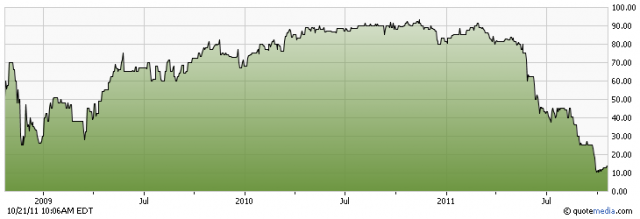Sterling Shoes (TSX: SSI) went into creditor protection today. The shares were halted at 1:27pm and the CCAA protection announcement came at 1:48pm. The TSX will delist the shares and debentures.
Investors would have had some advance warning given the announcement the company made on September 27, 2011 that they would not be able to make an interest payment on their convertible debentures. Their credit facility with the Bank of Montreal would have prevented them from making the payment.
At this point anybody that held equity in the company should have firmly jettisoned it and the company shares tanked from 37 cents the day before to about 12 cents after.
There still may be value in the debentures, although whatever slice of the company they are given in the post-restructuring is difficult to determine. The company had about $13M in secured debt and $25M in subordinated debentures. When compared to sales metrics (2010: $127M revenues, $54M gross profit) and potential profitability (i.e. there is ample room to cut SG&A by getting rid of under-performing stores), the company should be worth more than what the secured line of credit is worth – certainly, debenture holders going into the bankruptcy had not expected much, with the last trade going off at 13.5 cents on the dollar at closing.
The following is a chart of the debentures:
It is impossible for retail investors to get a fair shake at a company during a restructuring, but I do notice that Belkin Enterprises Ltd., lead by BC businessman Stuart Belkin, took a $2.573M face value stake in the Sterling Shoes debentures and announced this on September 2, 2011 on SEDAR. Was this a mis-timed investment or are they planning on participating on the subsequent recapitalization and capture value in a post re-organization stake?
I would expect such holders to get equity and warrants in the subsequent recapitalization.
